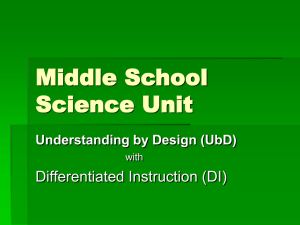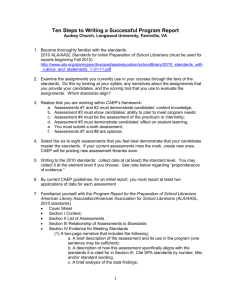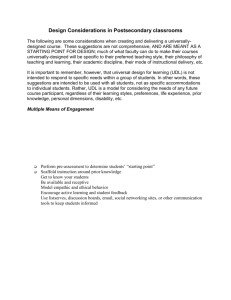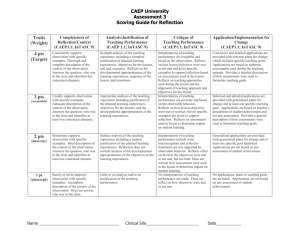Frequently Asked Questions - Association for Middle Level Education
advertisement
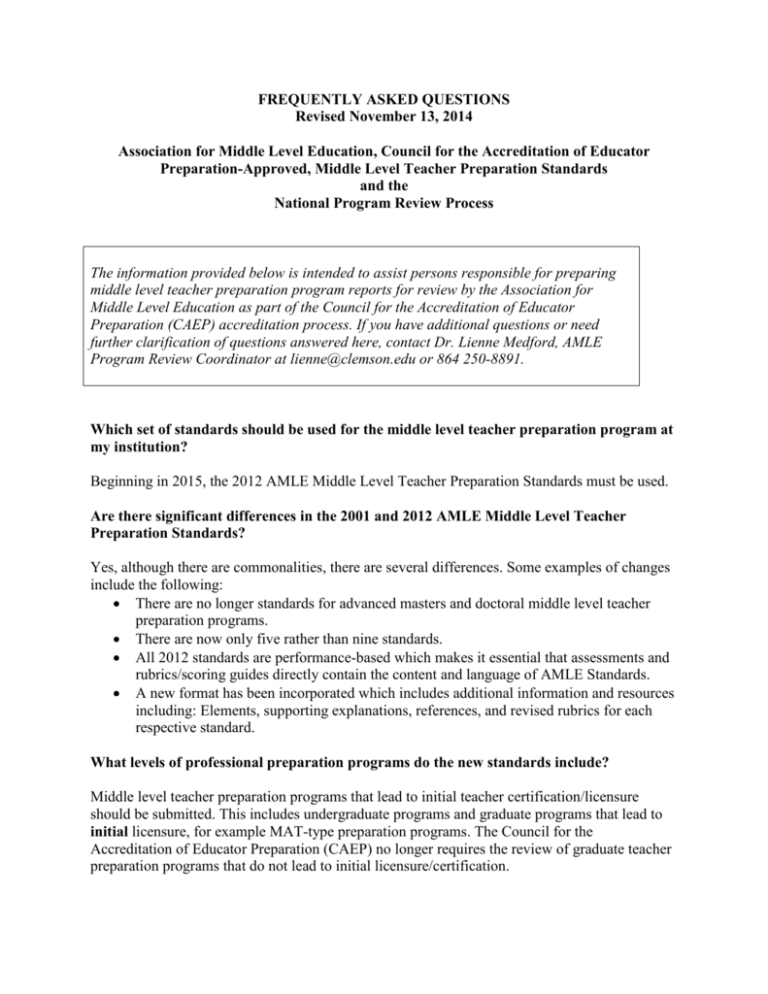
FREQUENTLY ASKED QUESTIONS Revised November 13, 2014 Association for Middle Level Education, Council for the Accreditation of Educator Preparation-Approved, Middle Level Teacher Preparation Standards and the National Program Review Process The information provided below is intended to assist persons responsible for preparing middle level teacher preparation program reports for review by the Association for Middle Level Education as part of the Council for the Accreditation of Educator Preparation (CAEP) accreditation process. If you have additional questions or need further clarification of questions answered here, contact Dr. Lienne Medford, AMLE Program Review Coordinator at lienne@clemson.edu or 864 250-8891. Which set of standards should be used for the middle level teacher preparation program at my institution? Beginning in 2015, the 2012 AMLE Middle Level Teacher Preparation Standards must be used. Are there significant differences in the 2001 and 2012 AMLE Middle Level Teacher Preparation Standards? Yes, although there are commonalities, there are several differences. Some examples of changes include the following: There are no longer standards for advanced masters and doctoral middle level teacher preparation programs. There are now only five rather than nine standards. All 2012 standards are performance-based which makes it essential that assessments and rubrics/scoring guides directly contain the content and language of AMLE Standards. A new format has been incorporated which includes additional information and resources including: Elements, supporting explanations, references, and revised rubrics for each respective standard. What levels of professional preparation programs do the new standards include? Middle level teacher preparation programs that lead to initial teacher certification/licensure should be submitted. This includes undergraduate programs and graduate programs that lead to initial licensure, for example MAT-type preparation programs. The Council for the Accreditation of Educator Preparation (CAEP) no longer requires the review of graduate teacher preparation programs that do not lead to initial licensure/certification. Should middle level preparation programs at my institution be submitted to CAEP for review by AMLE? You should be sure that the state partnership agreement in your state either requires or offers the option of having middle level teacher preparation programs reviewed by the Association for Middle Level Education through the CAEP program review process. Whether or not institutions are required to submit program reports is determined by the partnership agreement between CAEP and individual states. CAEP has partnership agreements with a number of states in which the terms of the partnership defer the program review process to the state. Other state partnership agreements require that CAEP specialized professional associations (SPAs) conduct program reviews. Still other states conduct state program reviews, but provide the option of having programs reviewed by AMLE for institutions wishing to seek national recognition of their middle level teacher preparation programs. Institutions located in states where the program review process is conducted by the state should contact their state agency responsible for program approval for further information on how program reviews are conducted. If the protocol in your state requires or allows programs to be reviewed through the CAEP program review process, you should refer to the information provided on the CAEP web site http://www.amle.org/AboutAMLE/ProfessionalPreparation/tabid/237/Default.aspx and/ or contact CAEP directly. The CAEP web site also contains information about partnership and protocol agreements for each partnership state. Additional information, including the 2001 and 2012 AMLE/CAEP-Approved Middle Level Teacher Preparation Standards, can be found on the AMLE web site. http://www.amle.org If your institution is submitting program reviews to CAEP for review by the SPAs, you need to determine whether your middle level teacher preparation program qualifies for review by AMLE. You should respond to the AMLE standards if your institution offers initial degree programs for the preparation of middle level teachers. AMLE does not review generalist middle level programs (e.g., those without content preparation requirements in subject matter, for example mathematics or English/language arts). AMLE reviews only separately organized teacher preparation programs that focus specifically and exclusively on preparing teachers to teach young adolescents. Young adolescents are typically ages 10 to 14 and are in grades five through eight. However, AMLE does not specify which grade levels are included in middle level teacher preparation programs since individual states define middle level education through their licensure regulations (e.g., grades 4-8, 5-8, 4-9, and 6-9). AMLE does not typically review programs that prepare teachers for grade levels that include both elementary and middle or middle and high school grades (e.g., grades K-8 or 6-12). If you have a program that includes grades K-8 and still provides specialized professional preparation for middle level teachers, contact CAEP or AMLE for the policy about these types of reviews (mcewinck@appstate.edu). Does AMLE recognize edTPA assessment data for documentation that AMLE Middle Level Teacher Preparation Standards are met? Aggregated data from edTPA assessments for Middle Childhood English/Language Arts, Middle Childhood History/Social Studies, Middle Childhood Mathematics, and Middle Childhood Science can be used to document that teacher candidates met AMLE Standard1: Young Adolescent Development, Standard 2: Middle Level Curriculum, and Standard 4: Middle Level Instruction and Assessment. edTPA assessments cannot be used to document candidates’ mastery of Standard 3 Middle Level Philosophy and School Organization or Standard 5: Middle Level Professional Roles. Will aggregated data from edTPA Middle Childhood assessments satisfy the Effect on Student Learning requirement? Yes, satisfactory scores on edTPA Middle Childhood assessments will fulfill this requirement. Does AMLE review middle level endorsement programs that do not result in a degree in middle level education? The answer depends on the nature of the program. The following policy is intended to help institutions determine which of their programs could be considered endorsements and/or add-ons (or a similar term used in their state) should be included in the unit review and be submitted for national program review if required to do so by their states. The first set of bullets in the following criteria describe what programs should NOT be submitted. The second set of criteria describe what programs should be submitted. If a unit is still unsure how to apply these criteria they should contact CAEP staff to make a determination. Programs that should not be submitted: Endorsements and add on programs that require only a few courses, insufficient content, and/or limited requirements are not included in the CAEP review and will not be listed among the offering of an accredited professional education unit. Minors in subject areas are not normally submitted for national program review unless the state agency requires them to be reviewed against national or state program standards. Short-term programs offered as professional development for teachers and other educators are not included in the CAEP review and will not be listed among the programs of an accredited professional education unit. Programs that must be submitted for SPA review (if required to do so by the state) and that are included in the CAEP unit review include the following: Endorsement and add-on programs that are similar in content and requirements to other programs within that content area. Programs that are of sufficient breadth and depth to meet the AMLE standards. Should middle level teacher preparation programs be submitted for review if they are new programs? New middle level teacher preparation programs should be submitted if all institutional approvals have been completed and the program is ready for enrollment of teacher candidates. It is essential, however, that the program review report include a thorough description of the assessment system including copies of rubrics/scoring guides that directly assess AMLE Middle Level Teacher Preparation Standards. It is essential that assessment rubrics/scoring guides use the content and language of the AMLE Standards. Explanations of how the rubrics/scoring guides are scored are also essential. If it appears to members of the program review board that everything is in order with the exception of the lack of assessment data, the program will be “nationally recognized with conditions.” The conditional status of recognition of the program will be removed if appropriate data are submitted within an 18 month period. Aggregated data from at least one application of assessment should be included in the Response to Conditions Report. Programs that wish to seek a deferment on submitting program reports because programs are new or have very low enrollments should contact CAEP for additional information. How much data should be submitted? For full recognition, programs are required to submit data that represent two applications of assessments. That is, the assessments must be given and data collected at least two times. If an assessment is in a class that is offered every semester, then the two applications could be satisfied in one academic year. If the assessment is in a class that is offered once per year, then the two applications would take two academic years. For revised and response to conditions reports, data from one application of the assessment are required for full recognition. Are there multiple formats/processes for submitting program reports? Yes, there are several options. Information about these options is found on the CAEP website. Can middle level teacher preparation programs be reviewed by AMLE if the teacher preparation unit of the institution is neither CAEP accredited nor seeking CAEP accreditation? No, program review is part of an overall accreditation process for institutions accredited, or in the process of seeking accreditation, from CAEP. Can programs from institutions that are CAEP accredited submit middle level teacher preparation programs for review at any time? No, the program review process is a part of either the initial or continuing accreditation process. Therefore, middle level teacher preparation programs are reviewed according to the time line followed by institutions. Details are available from CAEP. Is there a required matrix format that must be used in program review materials? Yes, matrices for these reports should be downloaded from the CAEP web site. Instructions for completing the program review process are also found on the CAEP web site. Programs must use the program report form and process to be reviewed by AMLE. Care should be taken to use the forms that are designed for the 2001 or 2012 AMLE Middle Level Teacher Preparation Standards. (The 2012 Middle Level Teacher Preparation Standards must be used beginning in 2015). Is a separate conceptual framework needed for the middle level teacher preparation programs? No, an explanation of how the middle level teacher preparation program operates within the unit conceptual framework is what is required. What happens when middle level teacher preparation programs are approved by AMLE? When middle level teacher preparation programs are approved by AMLE through the program review process, they become “nationally recognized.” Nationally recognized programs then appear on a list of nationally recognized programs on the CAEP web site. Members of the CAEP Board of Examiners consider the number of programs that have or have not received national recognition when making their recommendations about accreditation. Therefore, having nationally recognized programs increases the odds that the unit will be nationally accredited. Additionally, in some states, recognition of programs by AMLE is a prerequisite to continuing to offer those programs. What process is used to determine whether a middle level teacher preparation program is recognized (approved) by AMLE? The program review process is described in detail on the CAEP web site. If a program is not approved by AMLE, is there a process for resubmitting the program for additional consideration? Yes, a revised program report may be submitted for further consideration. The process to be followed is described in detail on the CAEP web site. Do all standards have to be met for a program to be approved/ recognized by AMLE? Yes, all standards have to be substantially met for programs to be approved and recognized by AMLE. Program reviewers use the preponderance of evidence principle when making decisions about program recognition. Do all elements of each standard have to be met for the standard to be approved? No, every element does not have to be met. Members of the program review board will use the preponderance of evidence principle to make judgments about whether each respective standard is met. However, it is highly recommended that all elements of each standard be included in program assessments and their rubrics/scoring guides. Is it possible to receive copies of successful program reviews so that I can see models that will help me better understand the review process? Copies of reviews of other programs are not available from AMLE. All materials submitted, as well as the resulting evaluation information, are kept confidential by AMLE so the integrity of the review process will be upheld. It is suggested that representatives from programs that have been nationally recognized by AMLE be contacted. It is likely that faculty from those programs will share their program review materials. A listing of nationally recognized programs is provided on the CAEP web site. Several examples of middle level program reports are available on the CAEP web site. Programs faculty at these institutions gave CAEP permission to post their program reports. These examples should not be viewed as the only way to create a successful middle level teacher program review report. There is also an Assessment Library on the CAEP web that provided examples of assessments used by other middle level teacher preparation programs that had successful program reviews. AMLE does not endorse a standardized approach to ways programs can respond to the standards. AMLE has worked hard to avoid being overly prescriptive in designing program standards and unduly limiting the ways programs can respond to the standards. Members of the AMLE Professional Preparation Advisory Committee have attempted to provide guidance without dictating specific ways in which the standards can be met. For example, specific courses are not required and the design of assessment plans is left to the discretion of program faculty. Should samples of candidate work be included in program review materials? No, samples of candidate work, including portfolios, should not be included in program review materials. What should be included are aggregated data based on multiple assessments that directly reflect the content and language of the AMLE Standards. Program assessments should include explicit expectations, distinguish levels of performance, and include authentic tasks. The resulting assessment data should be used to reach meaningful decisions regarding the success of teacher candidates and the middle level teacher preparation program. What is the minimum and maximum number of assessments that should be included in the program report? The minimum number of assessments is six and the maximum number is eight. AMLE does not require more than the first six assessments be utilized. However, it is recommended that all eight assessment opportunities be utilized to document meeting AMLE standards. It is difficult to document that all standards have been met when only six assessments are used. Should documentation of the positive effects of teacher candidates on student learning be included in the assessment plan? Yes, it is very important that assessments are included which demonstrate the positive impact of teacher candidates on student learning. Please see information on assessment requirement number five on the program review report form for more information. Are separate assessments required for each standard? No, many assessments provide information that includes multiple standards. Do results from standardized licensure test results help determine whether a middle level teacher preparation program is approved (recognized) by the Association for Middle Level Education? Yes, 80% of a program’s completers (as defined by Title II) must pass the content examinations in the given areas of specialization in states where such examinations exist for a program to gain or retain full national recognition. This requirement does not apply in states that do not have content examination requirements for licensure. The 80% requirement refers to the overall pass rate on the state tests. For example, when Praxis II Grades 5-9 is required in all content areas, the assessment data provided should represent the overall combined pass rate from all of the areas as opposed to 80% of sub-scores in each content area. Please see information on the CAEP web site for further information on this topic. Are two teaching fields (content areas) required in the AMLE standards? Study in two teaching fields (subject matter areas) is not required in the new 2012 standards. Two teaching fields are required at the initial level in the 2001 standards. However, only one teaching field is required at the advanced master’s level. What happens if my program is responding to the 2001 standards and requires only one teaching field at the initial level? AMLE program review board members are instructed to acknowledge that these programs will be recognized/approved by AMLE with only one content area (teaching field) as long as all other standards are met. In this situation, the program will be nationally recognized with the program review document listing the lack of a second area of study as an Area for Consideration. This section of the program review report will include a statement recommending that program faculty members consider adding a second area of study (teaching field). However, the national recognition in this situation is full national recognition with no conditions attached or changes required. If an institution has more than one middle level teacher preparation program, should multiple program review reports be submitted? Yes, when the traditional and post-baccalaureate programs are included in one report, it is difficult for program review board members to distinguish between requirements and other differences in the two programs. Submitting two separate program reports is not as time consuming as one might first think because many of the sections of the two reports will be the same. Do middle level teacher preparation programs have to file separate middle level program review reports to other Specialized Professional Associations (SPAs) for areas such as middle level mathematics, science, social studies, and English/language arts? No, middle level programs that prepare candidates in content areas and that meet the AMLE criteria for middle-level programs will submit program reports to CAEP/AMLE and not to each of the content area SPAs (NCSS, NCTM, NCTE, NSTA, ACTFL). Please see the following information: 80% of completers must pass state test in content areas Secondary program in content area must be nationally recognized by the appropriate content area SPA. Middle level programs could be recognized with conditions by AMLE if secondary content area programs are still in process. For those few middle level programs that do not have secondary preparation programs, 80% of the candidates will still be required to pass the state test in the content area and the state must ensure the adequacy of the content preparation. What are some pitfalls/problem areas to avoid when completing the AMLE program review report? Some of the most common pitfalls/problem areas are: Problem Area 1: Program assessments are generic and more appropriate for the unit rather than the program area, (e.g., INTASC Standards or generic scoring guides for all student teacher in the unit). This is one of the most common problems with programs that are not approved/recognized by AMLE. Program assessments must specifically reflect the content and language of the AMLE Standards. Assessments reflecting generic standards such as INTASC are not acceptable for middle level programs. It is essential that the content and language of AMLE Middle Level Teacher Preparation Standards be used when designing middle level teacher preparation assessments and accompanying rubrics. Showing a matrix with the AMLE Standards aligned with more generic standards will not result in approval and national recognition. Problem Area 2: Programs rely on grade point averages rather than on carefully designed rubrics/scoring guides. CAEP does permit the use of grade point averages as an assessment. However, AMLE highly recommends that this method of assessment not be used. It is very difficult for program review board members to determine how grade point averages document meeting specific standards. If the grade point average is used, the CAEP document regarding use of this method should be read. Problem Area 3: Rubrics/scoring guides used in internships and student teaching are generic to all majors and do not reflect the AMLE standards. They are really unit rather than middle level teacher preparation program assessments. It is essential that rubrics/scoring guides for middle level internships and student teaching directly reflect the content and language of AMLE Standards. Generic rubrics/scoring guides designed for use with all teacher education majors should not be used unless they include direct references to the AMLE Standards. A matrix showing generic rubrics and how they align with AMLE standards will not be accepted as documentation for successfully meeting AMLE Standards. Problem Area 4: Programs seem to be devoid of instruction that focuses on Standard 1: Young Adolescent Development and Standard 3: Middle Level Philosophy and Organization. For example, rubrics for program assessments do not include the content and language of these two standards. Lienne Medford AMLE Program Review Coordinator lienne@clemson.edu 864 250-8891
